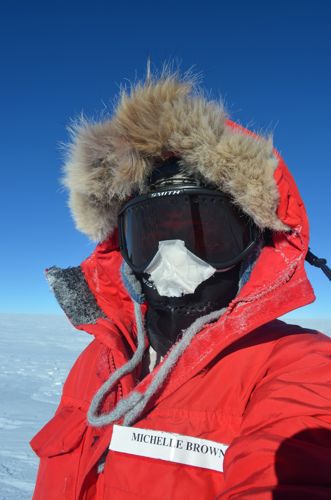Back at the Pole
Andy arrived with the cargo at AGO 4 today and I knew if I wanted to make it back to my classroom, I needed to get on that same plane back to South Pole Station. I hopped on the plane and took the 4-hour flight across 550 miles back to the pole. I will now be able to fly to McMurdo after New Years, and then will make the long journey home. Although I know I made the right decision to go home, I would have liked to stay a few more days out at the AGO site. Susan figured that I only spent 48 hours at the AGO, although I did manage to pack a lot in. Writing this journal entry from the luxury of my South Pole Station room doesn't have the same excitement and adventure as my tent out on the ice. Throughout my journeys in Antarctica, people keep telling me that I have to find a way to return. Although I appreciated my experiences, I didn't have a strong need to return to McMurdo or the South Pole. However, after leaving the AGO site, I feel a pull to return. Now I just have to find a way to get back there.


What was the AGO like?
The AGO site gave me an experience I had been hoping for since I arrived; I felt like I was really in a harsh and remote environment. Everywhere I looked there were miles of emptiness, and the cold and windy weather kept me bundled up with a sense of preservation I didn't have at McMurdo or the South Pole. The higher altitude also made it more challenging to work. I had to stop and catch my breath after walking quickly or shoveling a little bit of snow. These difficulties made me appreciate the smaller things in life so much more. Coming into the heated AGO to get water or eat a snack felt incredible. Last night Susan, Bob and I watched a movie after eating a delicious meal that Susan cooked. And although a tent on the ice sounds uninviting, crawling into a huge down sleeping bag and getting to sleep after a day of hard work felt divine. I savored these enjoyments, which normally slip by unappreciated.



Installing the Automated Weather Station
Most of my time at the AGO was spent installing an Automated Weather Station (AWS). The AWS will record information about the weather at AGO 4, providing important data for scientists and the public (including my classes) to study. Digging the 5-foot hole for the AWS was more challenging than I had expected. On Thursday I dug the hole for the station. During my shoveling, I came across a wire that connects to the AGO's magnetometer--luckily I didn't seriously harm it. To be safe, I dug a trench that was three feet away from the wire. Digging the trench in the high altitude and cold weather was challenging, but I went at a slow pace and often stopped to take in the vastness around me. By the end of the day, I had made a suitable home for the weather station.


Today, with Susan's help, I installed the towers that the weather instruments attach to. It was hard to make everything fit just right in the cold. Susan and I also managed to attach three instruments to the weather station: the wind vane, the temperature probe, and the humidity probe. Our fingers kept freezing as we tried to tighten screws and bolts, which required us to take frequent breaks to warm-up our fingers. I was hoping to install the antenna and pyronometer before I left, but our plane came in earlier than expected. Luckily Andy also knows how to put together the station and Susan and he will finish the task.

The AGO must go on!
Although I am back at the South Pole, I hope to keep writing about the important work that the AGO is doing! In my short time there I experienced so much. Here is a short video to give you a sense of the place:
http://
Questions
Have you ever visited a place that you knew you wanted to return to? What was it about that place that was so special?
How is AGO 4 similar to the South Pole Station? How is it different? How does it compare to McMurdo Station? How is it different?
Math Connections
The distance from AGO 4 to South Pole Station is about 550 miles. The pilots had to stop halfway between AGO 4 and the South Pole to refuel. It took a total flying time of 4 hours to reach the destination. Although the plane was half-full, the pilots filled the plane with 3 barrels of fuel at the halfway point.
a. What was the speed of the plane?
b. If the plane was full of fuel when it left South Pole, and half full when it left AGO 4, how many barrels of fuel would it require to fly to and from AGO 4 from the Pole? (Hint: remember the refueling station halfway in between)
c. Estimate the amount of fuel that is used per hour to fly on the twin otter.

Comments